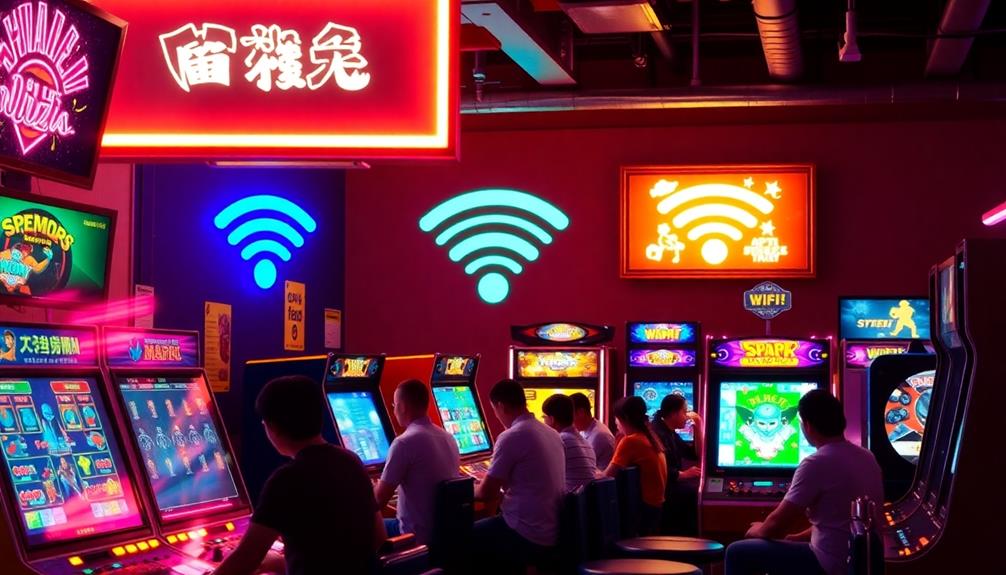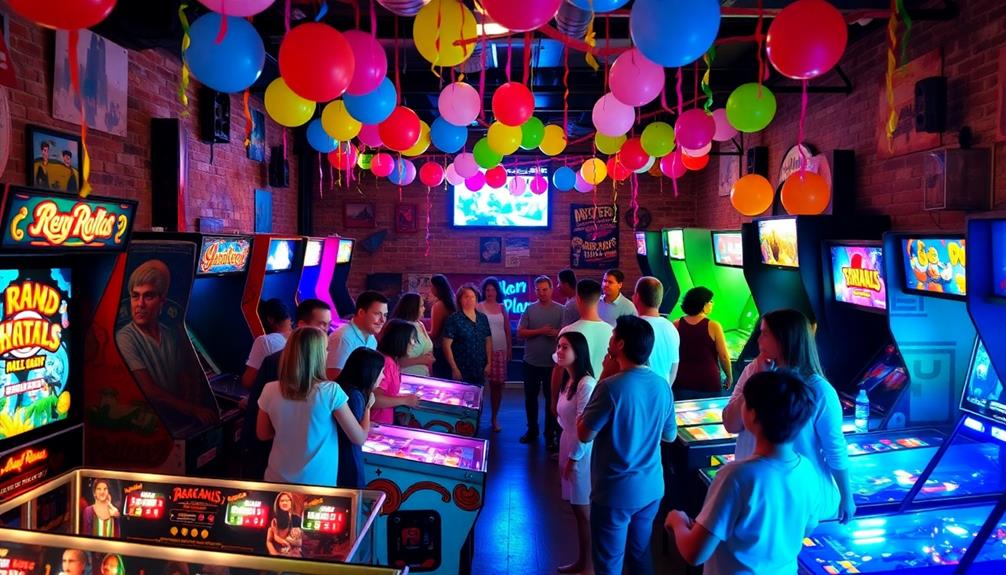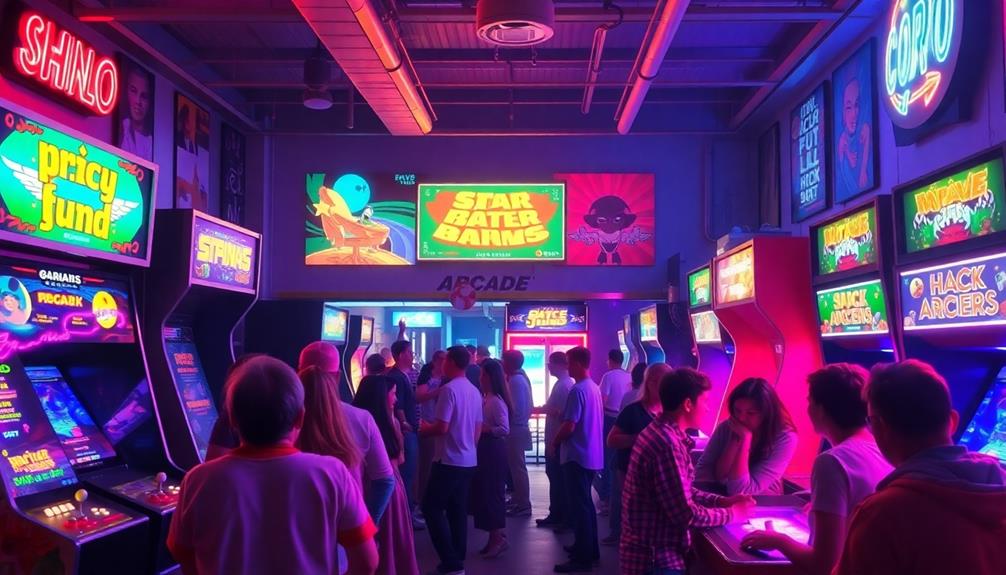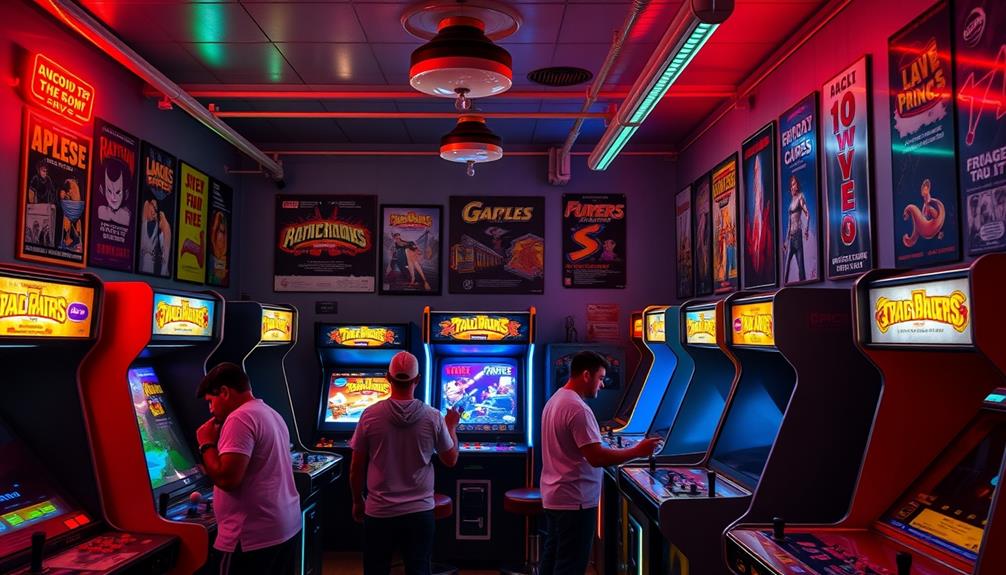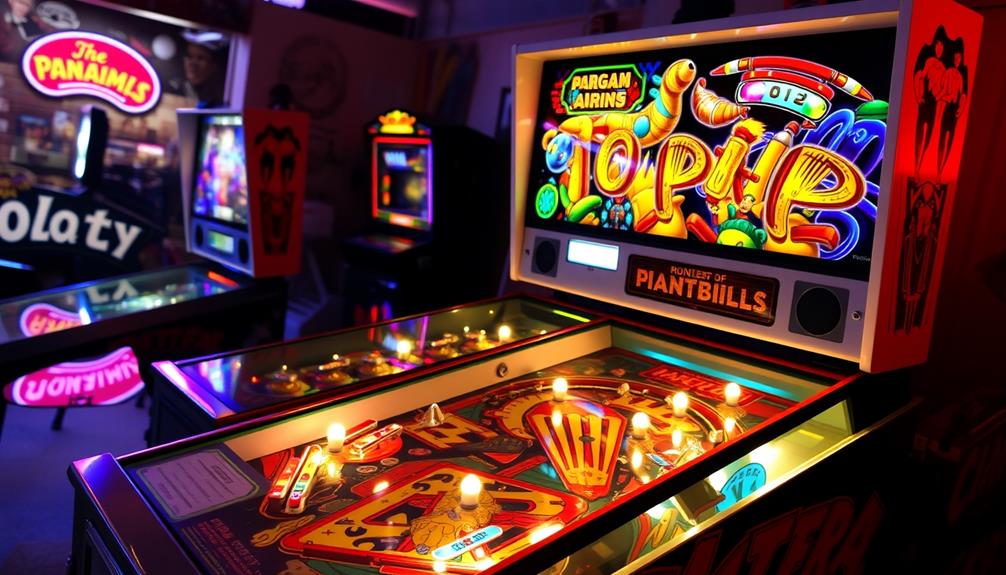Arcade game prices can vary significantly depending on the features and complexity. Simple joystick games may start as low as a few thousand dollars, while modern, advanced setups could cost tens of thousands. Standalone cabinets are typically more budget-friendly compared to multi-game systems that provide multiple options. Brand reputation also plays a part, with well-known brands like Capcom and Namco often commanding higher prices. It’s important to note that retro games are gaining popularity and their costs may be on the rise. Knowing these factors can help you make a well-informed decision when making a purchase, and there is a lot more to learn about owning an arcade.
Key Takeaways
- Arcade game prices vary widely, starting from low thousands for simple games to tens of thousands for advanced modern releases.
- Classic and retro games are generally more affordable, while popular brands like Capcom and Namco command higher prices.
- Multi-game cabinets typically cost more upfront but offer diverse gameplay options, adding value over standalone machines.
- Market demand significantly influences prices, with retro titles experiencing price increases due to collector interest.
- Budgeting for repairs and maintenance is crucial, as hidden issues can lead to unexpected costs after purchase.
Overview of Arcade Game Prices
When it comes to arcade game prices, you'll find a wide range that can fit various budgets. If you're eyeing simple joystick and button arcade games, you might be looking at prices starting in the low thousands.
However, if you're interested in modern releases with advanced features, be prepared to spend tens of thousands of dollars. Many of these modern machines incorporate advanced technology and design, similar to the top-rated pinball machines of 2024, which enhance gameplay experiences best rated pinball machines.
Standalone arcade cabinets generally come with different price tags compared to multi-game systems. Multi-game setups often provide a variety of arcade games at a single price point, which can be a more economical choice if you want multiple options.
The complexity of hardware and software plays a significant role in determining costs. Features like high-definition graphics and motion sensors can drive up the price of new releases, so keep that in mind when shopping.
Also, remember that prices can fluctuate based on brand reputation and regional market conditions. It's always a good idea to contact manufacturers directly for the most accurate pricing.
Seasonal promotions and the rising interest in retro games can lead to temporary price drops, making it an excellent time to snag a deal on arcade cabinets.
Key Factors Affecting Costs

Several factors influence the costs of arcade games beyond just the type of game you choose. The complexity of the arcade game is a significant consideration; simpler joystick and button games tend to be more affordable than modern games packed with advanced technology and features.
For instance, the best arcade machines for home game rooms vary widely in price based on their design and technology integration. When you look at hardware and software, keep in mind that intricate systems often drive up the price of arcade machines.
Brand reputation is another key player in the cost equation. Well-known brands usually charge more due to their perceived quality and reliability. If you want exceptional performance, expect to pay a premium.
Additionally, features like high-definition graphics, motion sensors, and multi-game capabilities can substantially increase the overall price of an arcade cabinet. These enhancements add to the entertainment experience but come at a higher cost.
Different Types of Arcade Games

Arcade games come in a variety of types, each offering a unique gaming experience. You'll find classic arcade games that feature traditional joystick and button controls, which are generally more affordable compared to modern options.
These retro titles have seen a resurgence in popularity, often driving up prices due to high demand among collectors and enthusiasts. For gaming enthusiasts, high refresh rates and low input lag in certain arcade machines can notably enhance the experience, especially in competitive settings, making some modern versions quite pricey due to these features top projectors for gaming enthusiasts.
On the other hand, modern arcade games leverage advanced technology, like virtual reality and motion sensors. These innovations can considerably increase their price because of the complexity involved in both hardware and software.
If you enjoy variety, multi-game cabinets might appeal to you. They allow players to experience different games within a single unit, typically requiring a higher initial investment but offering greater value through diverse gameplay options.
Additionally, niche market games cater to specific interests or themes, leading to unique pricing structures influenced by demand and limited availability.
Whether you're drawn to the nostalgia of classic games or the excitement of cutting-edge technology, understanding these different types of arcade games can help you make informed decisions about your gaming experiences.
Buying Considerations for New Owners

When you're ready to buy an arcade game, evaluating its condition is essential to avoid future headaches.
Understanding the mechanics of pinball machines can also help you identify any potential issues.
Don't forget to budget for potential repairs, as these costs can sneak up on you and sometimes surpass the initial price.
Understanding the game's state and planning for maintenance will help guarantee a smoother ownership experience.
Assessing Game Condition
Before diving into the world of arcade game ownership, it's crucial to assess the condition of the machine you're considering. A thorough inspection can save you from unexpected headaches and costs later on. Here are some key factors to evaluate:
1. Monitor Condition: Carefully inspect the screen. A faulty monitor can greatly increase repair costs and ruin your gaming experience.
Additionally, consider the essential oils for respiratory health that may help you breathe easier while you enjoy your new game.
2. Control Responsiveness: Test the controls to confirm they respond easily. Sticking or unresponsive controls can lead to frustration during gameplay.
3. Cabinet Integrity: Check for structural damage or signs of pests. A well-maintained cabinet reflects better care and less risk of hidden problems.
4. Maintenance Records: Request detailed maintenance records from the seller. Knowing how well the machine was cared for helps you anticipate future repairs.
Additionally, research the specific game model through community forums to understand common issues.
This knowledge empowers you to make an informed decision, guaranteeing you invest in a machine that's worth your time and money. Taking these steps will help you find an arcade game that's not just fun, but also a smart purchase.
Budgeting for Repairs
Owning an arcade game can be thrilling, but it's important to budget for repairs right from the start. Hidden issues often pop up, sometimes costing more than your initial purchase. For instance, a restoration for California Speed can run you around $600. You should also consider the condition of components like the monitor; a simple $7 resistor for KI2 could push your total expenses to about $1,100.
Here's a quick look at potential costs:
| Game Title | Estimated Repair Cost |
|---|---|
| California Speed | $600 |
| Killer Instinct | $1,450 |
| Hydro Thunder | $620 |
| KI2 | $1,100 |
Additionally, don't forget about moving fees and regular maintenance. Many owners find themselves investing significant time and money to keep their cabinets in top shape. It's also wise to budget for new parts and aesthetic upgrades, like marquee prints or control replacements. Keeping these considerations in mind will help you be better prepared for the financial commitment of owning an arcade game.
Repair and Maintenance Expenses

Repair and maintenance expenses can add up quickly for arcade game owners. When you think you're all set with your new machine, hidden issues can surface, leading to unexpected costs. Proper care and monitoring of your arcade machines, much like ultimate hamster care, can help prevent larger issues down the line.
Here's what you might face:
- Small Parts Replacement: You could spend a few bucks on minor repairs, like a $7 resistor, but don't let that fool you.
- Monitor Repairs: If your monitor fails, you're looking at $200 to $600, depending on the damage.
- Hidden Issues: You might discover pest infestations or faulty components after purchase, which can lead to significant extra expenses.
- Restoration Costs: A seemingly good deal—like a $225 arcade cabinet—could end up costing you nearly $600 in repairs.
These expenses highlight the financial commitment of maintaining arcade games. Budgeting for these costs is vital to guarantee your gaming experience doesn't turn into a financial burden.
Networking with fellow enthusiasts can help you find cost-effective repair solutions and share maintenance tips. Keep a close eye on your machines to avoid being caught off guard by these expenses!
Features Impacting Game Value

When you consider the value of arcade games, the complexity of their hardware and features plays a huge role in pricing.
Additionally, much like trends in sector performance metrics, the popularity of certain genres can influence game values, with classic arcade games often holding more appeal.
Games from well-known brands often carry a higher cost due to their reputation, while niche titles can fluctuate in price based on demand.
Understanding these factors helps you make informed decisions when purchasing or investing in arcade games.
Game Complexity and Features
Game complexity and features play an essential role in determining the value of arcade games, and you might be surprised by how much they influence pricing. Simply put, the more advanced the game, the higher the price tag.
Additionally, cultural beliefs often intertwine with game choices, influencing how players perceive value, much like astrology and attractiveness can affect self-image.
Here are some key factors that affect pricing:
- Game Mechanics: Simple joystick and button games usually cost less, while those with intricate mechanics demand more.
- Graphics and Tech: High-definition graphics, motion sensors, and VR capabilities can greatly increase the cost, making these games feel more immersive.
- Standalone vs. Multi-Game Systems: Standalone cabinets often have lower prices compared to multi-game systems, which offer a wider variety of games for a higher upfront cost.
- Niche Appeal: Games that cater to specific interests or themes can have unique pricing, driven by their rarity and demand.
Understanding these complexities can help you make informed decisions when shopping for arcade games.
Whether you're looking for a nostalgic classic or the latest tech marvel, knowing how features affect value will guide your choices and budget.
Brand Reputation Influence
Brand reputation greatly impacts the value of arcade games, shaping how players perceive quality and reliability. When you think about investing in an arcade cabinet, well-known brands like Capcom or Namco often come to mind. These established names typically command higher prices due to the trust and credibility they've built over the years.
You might notice that premium brands integrate advanced features like high-definition graphics or innovative gameplay mechanics, which can justify their elevated costs compared to simpler, less reputable alternatives. Additionally, the way celebrities like Nikki Reed and Ian Somerhalder promote a sustainable lifestyle can influence consumer preferences, creating a demand for games that align with those values.
Moreover, brand-specific licensing and merchandising play a notable role in adding value. You're likely to pay a premium for officially branded games, knowing they come with a sense of authenticity. Limited edition or collectible arcade machines further illustrate this point, often seeing substantial price increases in the secondary market.
Collectors and enthusiasts are willing to pay top dollar for these prestigious items, reflecting the undeniable influence brand reputation has on perceived value.
Ultimately, when you consider the long-term investment in arcade games, brand reputation is a key factor that can markedly shape your purchasing decision and the potential return on investment.
Market Demand Variability
The value of arcade games fluctuates based on various market demands, greatly influenced by the game's features and technology. You'll notice that the cost can swing dramatically depending on what a game offers.
For instance, classic joystick/button controls typically cost less compared to modern games outfitted with virtual reality or motion sensors. Understanding your budget is essential when making such purchases, as it can help you prioritize which games to invest in, and can prevent creating a personal budget that leads to overspending.
Here are some key factors impacting game value:
- Game Type: Standalone cabinets and multi-game systems have different pricing, affecting demand.
- Technology Level: Advanced features can drive prices up while simpler designs remain more affordable.
- Retro Appeal: As retro games gain popularity, classic machines see rising prices, often outpacing supply.
- Market Dynamics: Seasonal promotions and competition in online marketplaces can cause temporary price drops.
Understanding these aspects helps you navigate the arcade game market effectively.
Whether you're a collector or just looking to enjoy some nostalgic fun, these features markedly shape the value of what you're considering. So, keep an eye on trends and don't hesitate to seize the right opportunity!
Community Resources and Support

Arcade enthusiasts' passion for their favorite machines often leads them to form vibrant communities where support and resources flourish. Engaging with fellow fans can provide you with valuable insights on maintenance, repair techniques, and best practices for purchasing machines.
Online communities and forums are excellent places to share experiences, troubleshoot issues, and recommend reliable parts suppliers, all of which enhance your restoration process.
Networking with experienced arcade owners offers opportunities for mentorship, allowing you to learn from their successes and challenges. Many enthusiasts document their restoration projects on social media, creating visual guides and step-by-step instructions that are incredibly beneficial for beginners like you. These resources can demystify the process and boost your confidence.
Additionally, participating in local arcade meetups or events fosters connections and enables the exchange of resources, tools, and knowledge among community members.
You'll find that sharing experiences and tips with others not only enhances your skills but also deepens your appreciation for the arcade culture. By tapping into these community resources and support systems, you're setting yourself up for a rewarding journey in the world of arcade games.
Frequently Asked Questions
Are the Games Free in Arcade Club?
In an arcade club, you won't pay for each game individually. Instead, you'll enjoy unlimited play with your entry fee, allowing you to immerse yourself in a variety of games without worrying about extra costs.
Do Arcade Games Make Money?
Did you know that high-traffic arcade machines can earn hundreds to thousands of dollars monthly? Yes, arcade games make money through coin-operated play, special events, and by diversifying offerings like food and drinks.
Do Apple Arcade Games Cost Money?
Apple Arcade games don't cost extra beyond the subscription fee. For just $4.99 a month, you access over 200 games without in-app purchases or ads, making your gaming experience seamless and enjoyable across all devices.
How Much Money Do I Need to Open an Arcade?
Opening an arcade's like starting on a grand adventure. You'll need between $100,000 and $500,000 for initial investments, plus ongoing expenses around $10,000 to $30,000 monthly to keep the excitement alive.
Conclusion
In summary, understanding arcade game costs is like maneuvering through a maze—there are twists and turns that can surprise you. By considering factors like game type, maintenance, and unique features, you can make informed decisions whether you're buying or simply enjoying the games. Remember, the arcade community is a treasure trove of resources and support, ready to help you along your journey. So plunge into and enjoy the vibrant world of arcade gaming!

